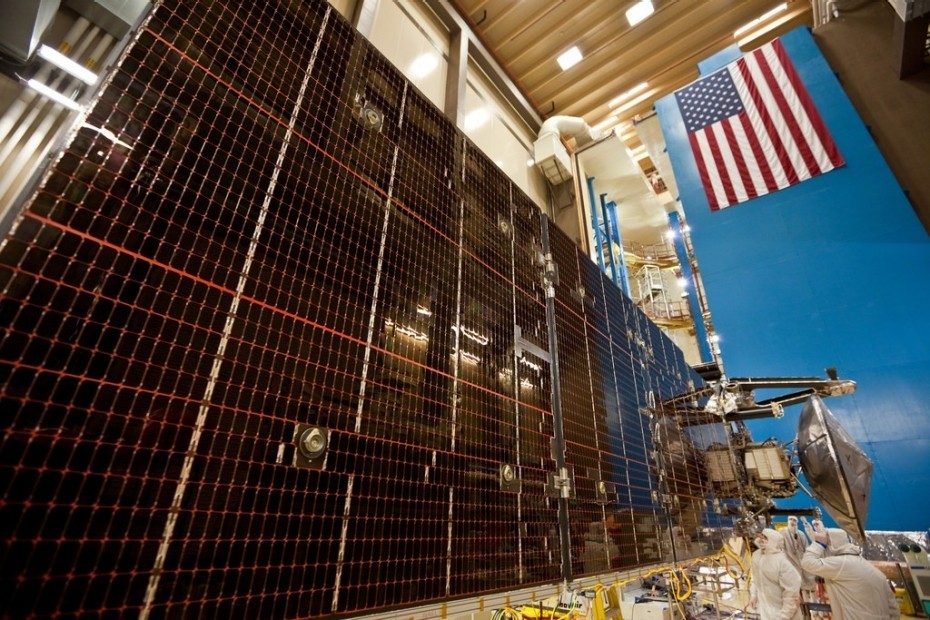When Galileo first set his sights on Jupiter in 1610, he discovered the first evidence that the sun – not the Earth – was at the center of our solar system. On July 4, 2016, the metaphoric center of our solar system for the Juno flight team will be Jupiter, as the Juno spacecraft reaches the enormous gas giant after a five-year, 1.76-billion-mile journey and maneuvers itself into a large, looping, elliptical polar orbit around the planet.
Jupiter Orbit Insertion, or JOI, is an intricately choreographed dance performed at unfathomable speeds with the largest, most radiation laced planet in our solar system.
At a precise time and location on July 4, Juno’s onboard computer will autonomously fire its main engine for 35 minutes to slow the spacecraft from its screaming-fast speed of 130,000 mph relevant to Jupiter. Relative to Earth, the speed is about 165,000 mph, making a 2,790 mile trip from New York to Los Angeles take only one minute and a 24,900 mile trip around the Earth would only take nine minutes.
This engine burn is critical: fire for too long and the spacecraft goes into too tight of an orbit; burn too short, the gravity doesn’t catch the spacecraft and it speeds off into deep space…there will be no second chances. Adding to the nail-biter moment is that there isn’t instantaneous knowledge all went as planned, as it takes 48 minutes for signals from Juno to travel through space back to Earth.
This means when mission control gets word the engine fired appropriately, Juno will have been in orbit – or not – for at least 13 minutes.
“There will be a tremendous sense of relief once we know we’ve successfully entered orbit with no anomalies,” said Kenny Starnes, Juno program manager and leader of the Mission Support Area at Lockheed Martin Space Systems near Denver. “It’s kind of like winning a late-round tournament game – you can celebrate for a moment, but you know there’s still plenty of work to do in the near future. Soon after JOI we continue our preparation of command sequences for the science mission to begin.”
Juno, which is about the size of a basketball court, was built by Lockheed Martin in Littleton, Colorado. Lockheed Martin engineers began work on Juno in 2005, and have been involved in the project’s many milestones ever since. It began the trip to Jupiter about five years ago, launching Aug. 5, 2011 from Cape Canaveral, Florida, and it’s currently jointly operated by a Lockheed Martin flight operations team in Littleton in addition to NASA’s Jet Propulsion Laboratory (JPL), Southwest Research Institute, and numerous institutions responsible for Juno’s extensive array of scientific instruments.
Juno will conduct an in-depth study of the giant gas planet Jupiter as part of NASA’s New Frontiers program. It’s led by principal investigator Dr. Scott Bolton, of Southwest Research Institute in San Antonio. The science mission has several objectives: investigate the existence of an ice-rock core; determine the amount of global water and ammonia present in the atmosphere; study convection and deep wind profiles in the atmosphere; investigate the origin of the Jovian magnetic field and explore the polar magnetosphere. The spacecraft’s nine instruments will provide data to improve our understanding of the solar system by helping us understand the origin and evolution of Jupiter. The gas giant is the solar system’s largest planet, more than two-and-a-half times as massive as all of the other planets combined.

Successfully completing the critical JOI is but one of a series of mission firsts: Juno is the first solar-powered spacecraft to fly to the outer planets, and it will venture within about 3,000 miles to the cloud tops of our solar system’s largest planet –– closer than any other spacecraft before it. It’s also the first planetary spacecraft to fly 3-D printed titanium parts.
“This is also the first time we’ve ever gone into polar orbit around Jupiter, under its lethal radiation belts and this close to the planet,” Jeff Lewis, Juno lead flight engineer at Lockheed Martin, said. “It’s an example of how the Juno team is daring to do what hasn’t been done before.”
The planet is surrounded by an intense energy field of charged particles traveling at nearly light speed – the harshest environment in the solar system – that are atrociously bad for computers and other sensitive instruments. Juno will have run-ins with this extreme radiation on each of its planned 37 low dips over the planet during the mission. In total, the spacecraft will experience the equivalent radiation of more than 100 million dental x-rays.
Juno will avoid the most dangerous regions by approaching over the north, dropping to an altitude below the deadly radiation belts and then exiting over the south. The spacecraft also has a special titanium vault designed to shield critical computers that drive the spacecraft and its instruments; another first in spacecraft design.
“Jupiter is a whole different animal,” Starnes said. “The planet is just massive – it’s both the largest and fastest spinning planet out there. This is one of many aspects that makes this mission unique to others we’ve participated with in the past.”




